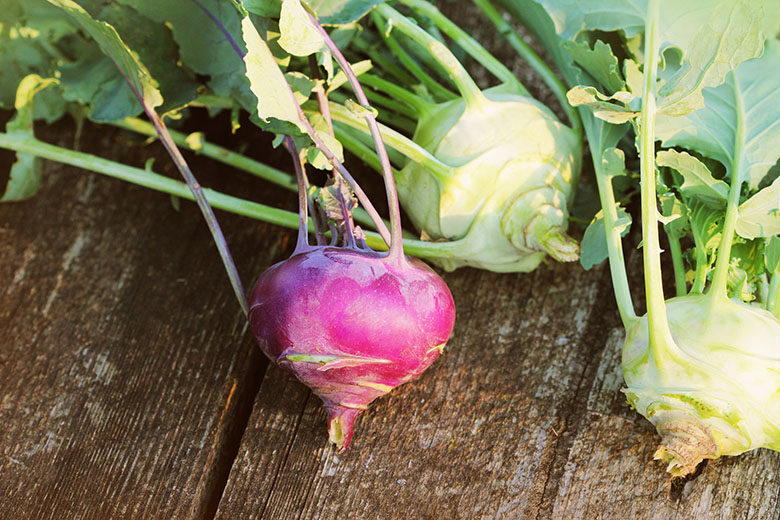
Sweet and peppery kohlrabi is a favorite ingredient in Central European cuisine. The unusual name actually is just a German mash-up of “kohl” (meaning cabbage) and “rabi” (meaning turnip). Kohlrabi is also an integral component in the diet of those living in Kashmir (where it is referred to as “Ganth gobi”) an area divided between India, Pakistan and China.
Kohlrabi’s appearance can be best described as a bulbous bottom with multiple coarse stems protruding from the top. There is diversity in its color, with the outside coat customarily found in a light green or deep purple. The inside is more consistent, with the flesh usually a creamy white color. Though the tastes are similar, purple kohlrabi has a spicier punch compared to green kohlrabi’s sweeter profile.
How to Cook Kohlrabi
Grouped in the same Brassica genus as broccoli, kale, cauliflower and Brussels sprouts, kohlrabi is versatile: it can be eaten raw or cooked, and served hot or cold. Though kohlrabi is rarely appreciated for its looks, it, thankfully, has very thick skin. ![]() Its flavor range makes it a nice addition to a meal or a stand-alone snack. Some tried-and-true uses of kohlrabi include:
Its flavor range makes it a nice addition to a meal or a stand-alone snack. Some tried-and-true uses of kohlrabi include:
- stewed in a chunky soup or pureed into a cream-based soup
- roasted or turned into a fritter, as you would a potato or zucchini
- in a dish made with potent Indian spices
- prepared with nothing more than salt and pepper
- sliced and added to salads like a radish
- steamed like broccoli
Kohlrabi’s Nutritional Profile
Kohlrabi’s hidden secret is its vitamin C content. Citrus may steal the vitamin C glory, but 1 cup of kohlrabi contains approximately 80 milligrams of vitamin C ![]() — more than an adult female’s daily requirement of 75 milligrams, and close to an adult male’s recommended 90 milligrams per day. Additional nutrients include potassium, copper, magnesium, iron, calcium, and A and B vitamins.
— more than an adult female’s daily requirement of 75 milligrams, and close to an adult male’s recommended 90 milligrams per day. Additional nutrients include potassium, copper, magnesium, iron, calcium, and A and B vitamins.
How to Pick a Kohlrabi
Kohlrabi is typically in season during the colder months of November through March. Do you see signs of mold or over-maturity, such as cracks and cuts in the surface? Does the bulb feel oddly light for its size? Does the outside have a woody texture? If you answered yes to any of these questions, put that kohlrabi back in the pile. Instead, choose a smaller bulb, about 3 inches in diameter, with a more pliant, smooth surface. If the leaves are still attached, look for ones that are crisp.
Now that the secret is out, health-conscious consumers should look past kohlrabi’s rough exterior and appreciate the satisfying taste and nutritional bonanza inside!


